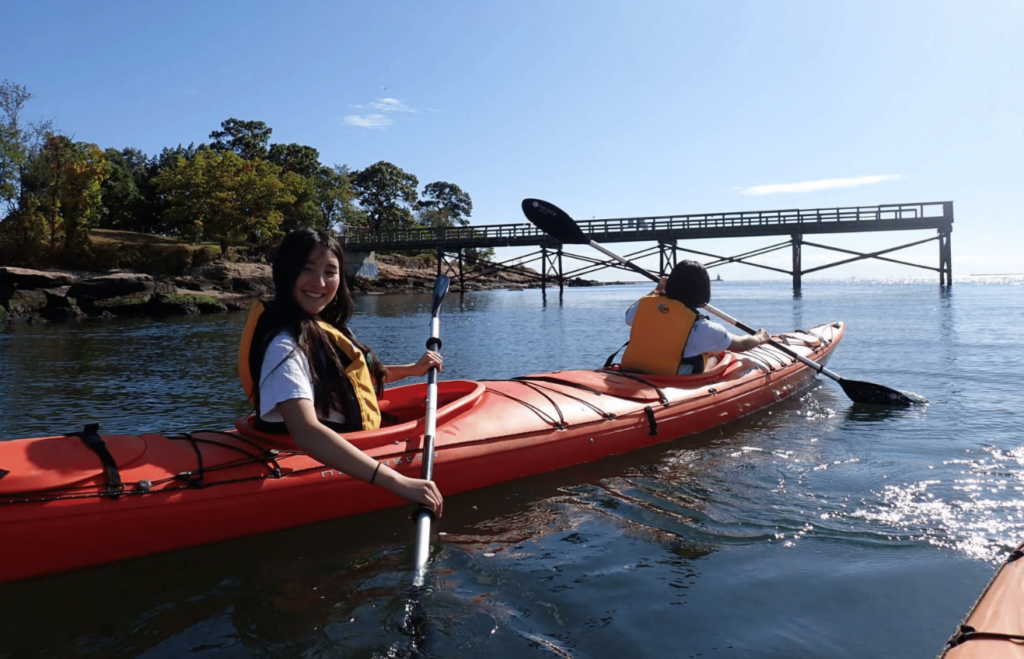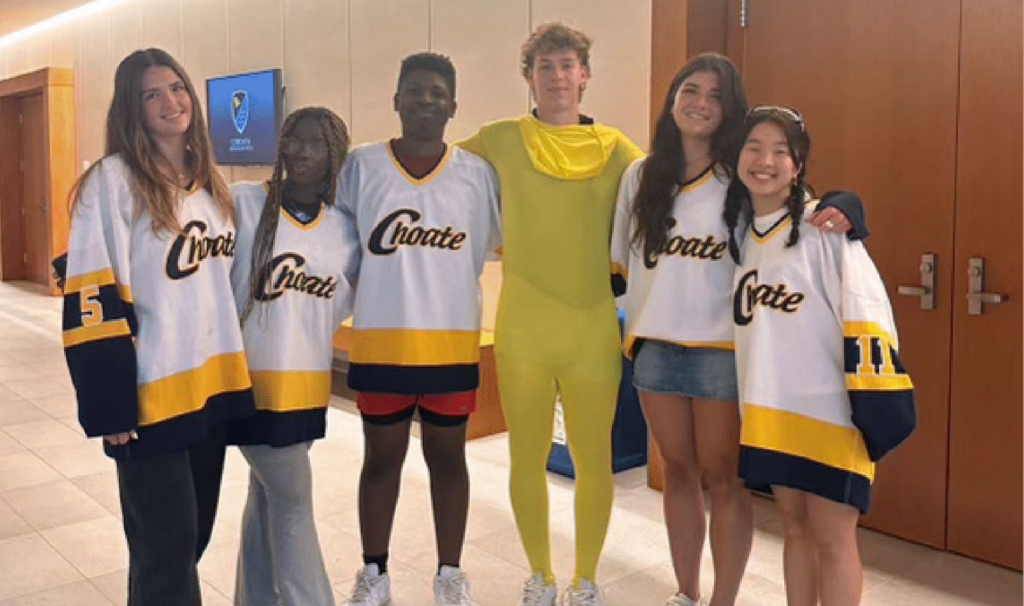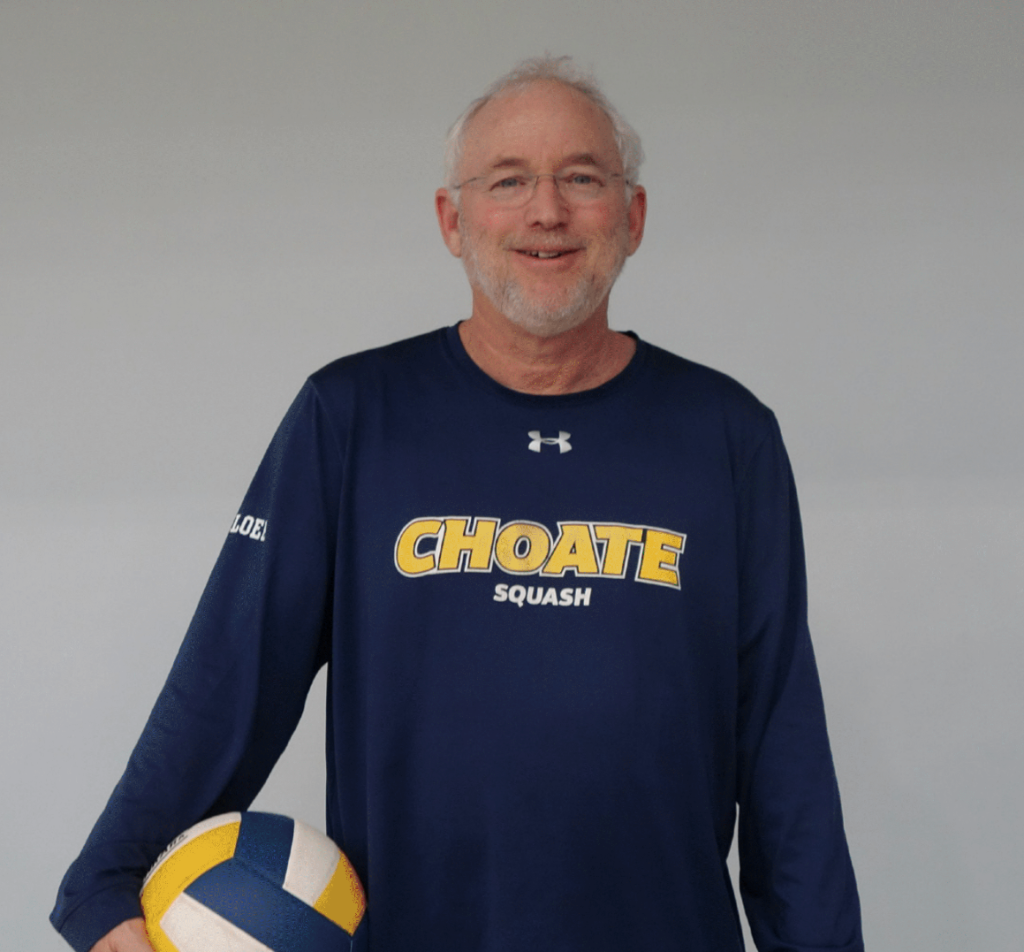By Francesca Howard ’26 / Reporter

Ada Tieanworn ’26 and Nicha Tongdee ’26 share a kayak at Lighthouse Point Park.
While some students are breaking a sweat in the gym or battling it out on the field, a few are happily paddling along the Quinnipiac River, soaking in all the natural beauty Connecticut has to offer. With no scoreboard, roaring crowd, or pressure to compete, Choate’s intramural fall kayaking is a sport like no other. Led by Science teacher Mr. Ben Small and Chinese teacher Mr. Ian Wollman, this activity has become a cherished alternative for students looking to try something new. Meeting twice a week on Monday and Wednesday afternoons, the group heads out to a local river, lake, or stream, where they warm up, hop in their kayaks, and paddle for an hour or more.
When he first came to Choate eight years ago, Mr. Wollman was assigned this coaching position and has since come to see kayaking as more than just a sport. “The time away from cell phones, the time in nature, on the lakes, rivers, ponds, and streams of Connecticut is … really valuable time that’s hard to find elsewhere at Choate,” he said. “The opportunity to get out into the natural world is excellent, but also getting to share that with students is even better.” For Mr. Wollman, the program enables students to forge connections both with the environment and with each other. Given Choate’s packed schedule, finding moments to unwind, have fun, and appreciate the world and people around you is a rarity. “It’s a pretty great way to spend an afternoon,” he concluded.
Many participants share this sentiment. Reflecting on his first day on the water, Jamie Sherriff ’27 said, “We were going out in the lake, and I got a little cocky. I jumped in the kayak, tried to go quickly, and flipped.” Though this initial mishap could have been discouraging, Sherriff embraced the challenge and quickly developed a passion for kayaking. Part of the reason he loves it so much comes from the sense of tranquility he feels while paddling. “It was very serene, very calm — just reconnecting with nature,” he said.
Sherriff also appreciates the flexibility that kayaking offers. He said, “You can socialize with the other people on the team if you’d like, or you can just relax and not talk at all if that’s what you want.” Unlike other sports, there’s no rigid playbook to follow and no intense pressure of competition. You get to set your own pace because kayaking adapts to you. Sherriff contrasts his experience on the water with his involvement in other athletic activities. “With some sports, sure, it’s something that I enjoy, but there are days when you don’t want to be at practice,” he said, adding that the demanding nature of traditional sports can sometimes feel burdensome. However, he feels differently about kayaking. “That’s something I don’t experience with kayaking. Maybe it’s because it’s only twice a week, maybe it’s because it’s so chill and calm, but it’s something I always look forward to,” he said. For Sherriff, kayaking is something he “gets” to do, rather than something he has to do.
Nicha Tongdee ’26, a second-year kayaker, similarly appreciates how it offers a break from the intensity of other commitments. “I feel like a lot of activities like sports take up a lot of your time and energy, but this is just kind of something that is de-stressing,” she said. Tongdee is particularly grateful for the coaches’ support and encouragement. “They’re so sweet and so supportive,” she noted. Tongdee encourages newcomers to try their hand at kayaking. “Even for people who aren’t in kayaking, if you do have a Monday or Wednesday off, just message Mr. Small or Mr. Wollman if you want to come on one kayak,” she said.
But it’s not all about floating along rivers and appreciating the fall foliage. Each kayaking session begins with the basics. Participants learn how to steer, balance, and even self-rescue if the kayak tips over. Though it may not be as intense as other sports, kayaking still offers paddlers a chance to push themselves. “The hard part is the stamina,” Ada Tieanworn ’26, another veteran kayaker, said. “If you paddle for a while, your arms will get really tired.”
Kayaking is far from a solo sport. In many ways, it operates like a team. “We get students who have a lot of experience with kayaking; we get students with no experience in kayaking,” Mr. Wollman said. “We teach the same techniques no matter what.” By pairing less experienced kayakers with returning participants, Mr. Small and Mr. Wollman ensure that everyone, regardless of skill level, feels confident on the water. Even if someone tips over, it’s a team effort to help retrieve their paddle, get them back into their kayak, and pump the water out. With only a handful of participants, everyone gets to know each other quickly. This camaraderie makes kayaking less daunting of a pursuit than other sports might be. If you’re willing to dip your toes (and occasionally more) into something new, kayaking might just be the sport for you.




